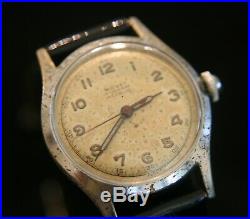
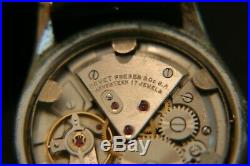
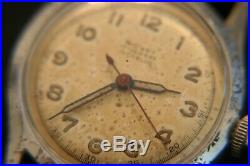
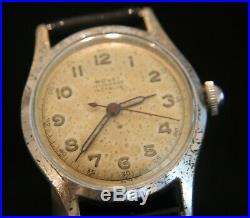
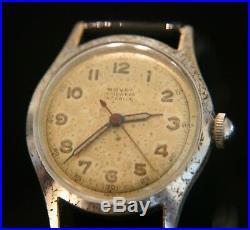
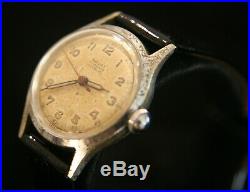
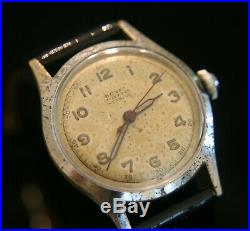
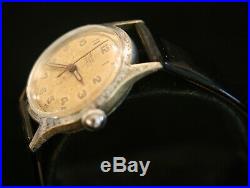
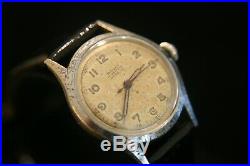
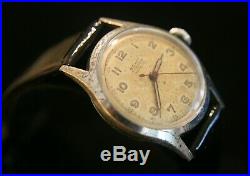
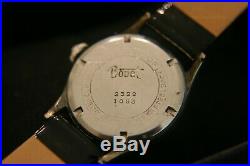
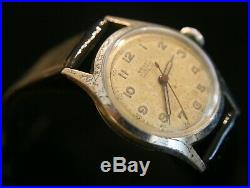

This is a very rare, vintage 1940’s Swiss 17 jewel men’s Bovet Freres military wristwatch that is running strong and has aged well. While the 31 mm case, excluding lugs and cushion crown, shows a lot of surface scratches and some brassing as the highly magnified photos show, but who knows what this timepiece has seen over the past almost 80 years! The dial is parchment with an aged patina that suits it well. While the black outlined syringe hour and minute hands have lost their original luminescent properties, they are in excellent condition as is the black center sweep. The military numbers are raised and clear as is the black outer chapter, all under a bright new crystal. The Swiss 17 jewel manual wind movement, signed Bovet Freres & Co. Sa, sets and winds smoothly, is running well, and keeping good time. It has a signed “Bovet”, screw-down stainless steel back and has been fitted with a new supple black genuine leather 16 mm strap with stainless buckle. Bovets Origins & Early History. Bovet was brought to life by four brothers but its firm foundation is often credited to Édouard Bovet. Born in 1797 in a small village called Fleurier in the Swiss Neuchâtel municipality, he learned the art of watchmaking from his father, Jean Frédéric Bovet. Although Swiss watches are often associated with Geneva, Fleurier is where Bovet grew to greatness. The industry was introduced in the residing Val-de-Travers region as early as 1730 and grew exponentially throughout the early 19th Century. In 1814, Édouard and two of his brothers, Alphonse and Frédéric, left their hometown to study watchmaking in London. After a few years, Édouard headed for Canton, China in 1818 under the British firm Ilbury & Magniac as a watch repairer. He took four of his pocket watches with him, which he was able to sell for 10,000 Swiss Francs in gold. Realising the potential of this new and yet unexplored market, he set up a company with his brothers in 1820. Meanwhile, the fourth brother, Charles-Henri, oversaw manufacturing from Fleurier in Switzerland. Tackling & Dominating The Oriental Market. Bovet wasnt the first watch manufacture to target the Chinese market. Aside from Édouards previous employers and Jacques Ullmann & Cie, Vacheron Constantin. Had already established a foothold in Imperial Northern China. However, Bovet flourished in the southern regions. Thanks to their superior quality and ornate design, they became an attractive commodity for the upper classes. Their reputation grew to such as extent that any luxury watch was referred to as a Bo Wei and synonymous with high-end watches in the everyday Chinese language. Port of Canton, 19th Century. Featuring pearl ornaments and finely-crafted enamel miniature painting, Bovet watches were highly desirable. The movements were often finely engraved and encased in glass to be admired from the back. Furthermore, Bovet watches were considered a financial asset. Such watches were often accepted as forms of payments as an alternative to currency. Bovet even developed dials with Chinese hours to make them more readable than Western hours. On his return, he built the Bovet house, which would become known as The Chinese Palace. This eventually became the city hall but today houses the Fleurier Quality Foundation, which was partly founded by Bovet. Due to the Prussian rule in Switzerland and being a sworn Republican, he was exiled soon after. Édouard then continued watchmaking in Besançon, France. During this time, Bovet established a manufacture in Canton. However, the growing unrest caused by the Opium Wars forced them to move to a smaller one in Macau. Counterfeits & The Opium Wars. Bovet Certificate of Authenticity. Counterfeiting proved to be an obstacle that would regularly undermine Bovets integrity. Chinese-made fake Bovets were often found in circulation and the family aimed to counter this with certificates of authenticity and hallmarks. Eventually, along with growing French and American competition, it caused the Chinese watch market to collapse in the 1850s. Although Édouard Bovet died in 1849, the company continued to innovate under his brothers care. In 1855, Bovet was awarded a gold medal at the Paris Exposition Universelle for a pair of perfectly identical watches ordered by the Emperor of China. Unfortunately, the Opium Wars continued to disrupt Bovets activities. Bovet In The 20th Century. Under the new management, Bovet nevertheless continued activity in China but its success slowly waned. Eventually, the Chinese market drew to a close and Bovet produced fewer watches. Instead, it concentrated its efforts on manufacturing services for other watch brands. Some time later, it was bought by Jacques Ullmann & Cie who also prospered from the 19th-Century Chinese market. Eventually, Albert and Jean Bovet obtained the name. Under their management, Bovet developed a number of chronograph patents including the mono rattrapante. This intriguing design allowed the second hand to be paused for a reading while the mechanism continued running. Unfortunately, the named and facilities were passed on to Favre-Leuba in 1948 who themselves stopped producing Bovet watches in 1950. It wasnt until 1966 that they were passed on to a cooperative. Throughout the late 1980s and 1990s, Bovet was passed between various investors but rarely made branded timepieces during this time. Bovets future was uncertain until the turn of the century. The item “Very rare men’s 1940’s WWII vintage Bovet Freres 17J Swiss military wristwatch” is in sale since Friday, October 11, 2019. This item is in the category “Jewelry & Watches\Watches, Parts & Accessories\Wristwatches”. The seller is “stonehengewatchcompany” and is located in Houston, Texas. This item can be shipped worldwide.
- Gender: Men’s
- Watch Shape: Round
- Case Color: Chrome
- Case Material: Chrome over brass
- Movement: Swiss 17 jewel Manual Winding
- Band Color: Black
- Age Group: Adult
- Display: Analog
- Lug Width: 16 mm
- Brand: Bovet Freres
- Case Size: 31 mm
- Face Color: Parchment
- Number of Jewels: 17 Jewels
- Country/Region of Manufacture: Switzerland
- Style: Military
- Caseback: Screwback Case
- Dial Style: 12-Hour Dial
- Band Material: Genuine Leather
- Features: Acrylic Crystal
- Case Finish: Polished
- Band Type: Two-Piece Strap

